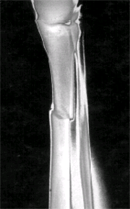Ultrafast healing
Ultrafast healing

thousands of people suffer fractures that do not heal easily. New research shows that pulsed, low-intensity ultrasound treatment helps mend fractured bones. More than 80 per cent of patients, with fractured bones that had failed to fuse, benefited from the therapy, according to a report presented at the recently held meeting of the American Academy of Orthopaedic Surgeons in Anaheim, California, usa . Each year in the us , as many as 250,000 people suffer a fracture that will not fuse properly.
According to Bruce Heppenstall, orthopaedic surgeon from the University of Pennsylvania School of Medicine, Philadelphia, who is the lead author of the study presented at the Anaheim meet, patients are left with two alternatives when fractures do not heal: wearing a brace for the rest of their lives or amputation of the damaged limb. When slow-to-fuse fractures were treated daily with ultrasound, more than 90 per cent healed, according to co-author Joseph M Lane, professor of surgery and assistant dean at the Cornell University Medical College, New York. Almost 85 per cent of bones that had failed to fuse with previous treatments, including surgery, mended after ultrasound therapy, he says.
In ultrasound treatment, the body is exposed to very high frequency, inaudible sound waves. This stimulates the conversion of cartilage into bone, Heppenstall explains. When a bone begins to heal, cartilage first fills the break. In most cases, the cartilage eventually absorbs calcium, hardens, and then turns into bone. For unknown reasons, the cartilage fails to calcify in some cases. The researchers report that when ultrasound beams are pulsed at a fracture for 20 minutes a day, blood flow to the break increases and more calcium is released to the bone.
In Heppenstall's study, 429 patients, with fractures that had failed to fuse despite repeated surgeries, were given daily ultrasound treatment. They were split into two groups. The first group comprised 313 patients for whom at least three months had passed since their last surgical procedure. In the second group were 169 patients who had suffered a fracture at least nine months earlier. With time, 80 per cent of the 313 patients ended up with a fused fracture, while 88 per cent of the 169 patients were healed.
Many us athletes who have had fractures are using the Sonic Accelerated Fracture Healing System ( safhs ), a battery-operated, hand-held device that delivers ultrasound pulses directly to the fracture site. Unlike electrical stimulation devices that use energy currents in a similar way to heal long-lasting fractures, safhs is specifically designed to speed the healing of new or fresh breaks. About 20 minutes of exposure to ultrasound is considered adequate.
The therapy uses the same intensity as a foetal sonogram, so it is obviously very safe. At the cellular level, pulsating ultrasound creates a mechanical force on the bone to help stimulate new bone growth. Low-intensity ultrasound produces minute mechanical strains within the fracture and improves blood flow to the fracture site to stimulate healing. This device costs about us $2,500, and has become quite popular among athletes. It is also recommended for the elderly.







